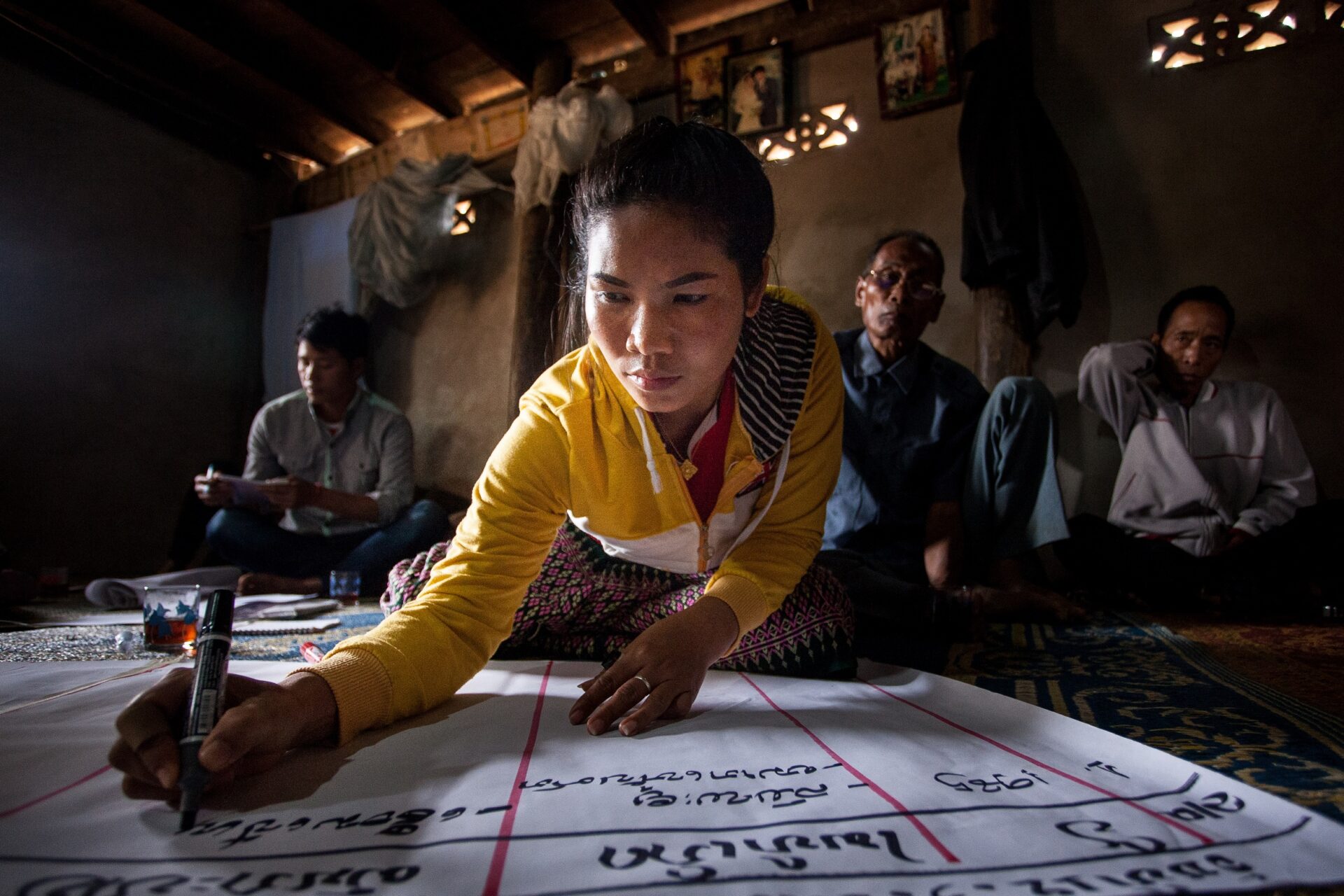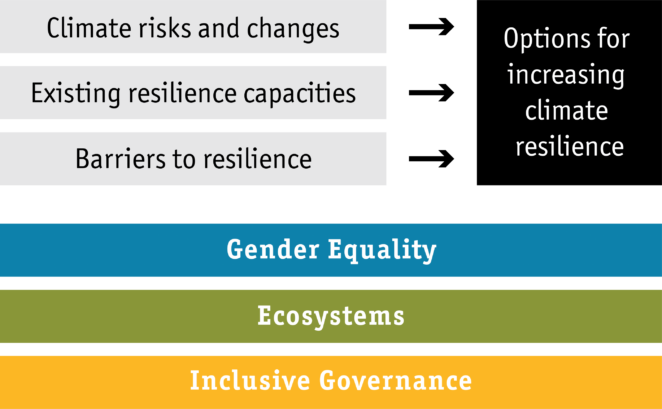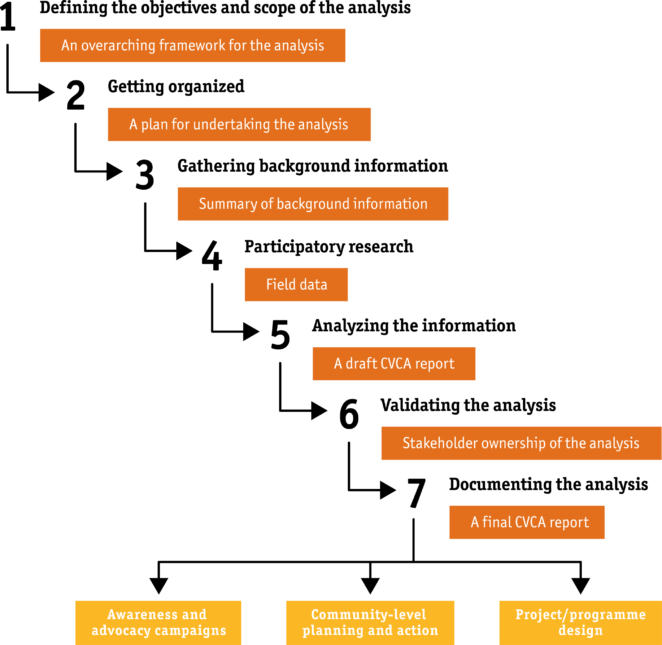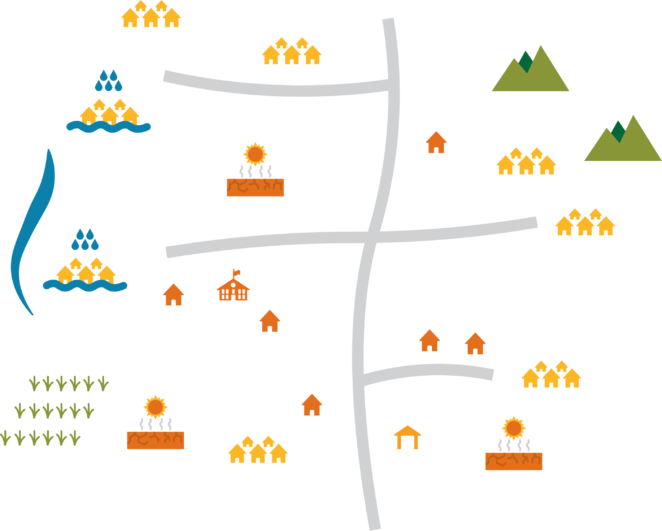Article /
CARE Climate Vulnerability and Capacity Analysis Handbook: Second Edition

Introduction
The Climate Vulnerability and Capacity Analysis (CVCA) is a tool used to gather and analyze information on community-level vulnerabilities to and capacities for climate change. It informs the identification of actions, at the community level or more broadly, that support communities in increasing their resilience to climate change.
The CVCA Handbook was first developed in 2009. Recognizing the context-specificity of climate impacts, as well as the socioeconomic dimensions of climate change adaptation, we developed the CVCA Handbook to guide practitioners in analyzing vulnerability to climate change and adaptive capacity at the community level. This second edition of the handbook aims to integrate learnings from the last 10 year with a particular focus on gender, ecosystems and governance to be specifically considered in all steps of the CVCA.
*Download the full publication from the right-hand column. A summary of the publication is provided below. Thispublication is also available in French.
The CVCA process in a nutshell
What is the CVCA?
The CVCA is a 7-step process, as described in the next section. It details a set of guiding questions to analyze the data collected around the following key issues (see graph below). It pays particular attention to three major cross-cutting issues – Gender Equality, Ecosystems and Inclusive Governance – that help define specific options for increasing climate resilience

How can the analysis be used?
It can be used in community-level planning and action, awareness and advocacy campaign, and projects and programs design:
- The CVCA can be one step in developing a community adaptation plan. It also facilitates the inclusion of such community plans in local development plans. If this is how you plan to use the CVCA, stake-holders’ involvement is crucial, and additional tools (e.g., visioning) for developing adaptation plans should be used.
- CVCA findings can be used as a basis for developing campaigns for systemic change and influence national and subnational adap-tation planning processes. If this is your main objective, you might consider including additional stakeholder mapping exercises
- The CVCA can also be used for integrating climate change risks into project and program design. In that case, it can be used in a slightly lighter way and eventually on a larger scale.
How long will the CVCA take?
The amount of time the CVCA process takes depends on: the scope of the analysis and your main objectives, the number of stakeholders involved, the availability of secondary information, presence in and relationship with the community and stakeholders. It might take you from 1 month to a year (if included in an adaptation planning process).
The CVCA step by step
The CVCA is a 7-step process using different methodologies of information collection: secondary research, key informant interviews and participatory tools that capture local perspectives and traditional knowledge.

STEP 1: Defining the objectives and scope of the analysis
- Clarify the purpose of the analysis, which can be used for community-level planning and action, awareness and advocacy campaigns, and program design.
- Decide on the focus and depth of the analysis:
- Scope: type of information, time frame, unit of analysis; stakeholders to be involved
- Resources: time available, financial resources, existence of data and information.
STEP 2: Getting organized
- Assemble a team with required knowledge on local language and contexts, climate change, gender quality, ecosystems and governance.
- Adapt the research process to your context and objectives.
- Agree on roles and responsibilities.
STEP 3: Gathering background information
- Review and synthesize available climate information for the target area.
- Gather any additional secondary information needed.
- Map institutional actors and talk to key informants.
STEP 4: Participatory research
- Meet with community leaders.
- Train facilitators.
- Undertake focus group discussions using the CVCA field guides included in the CVCA Handbook such as the Hazard Map, Vulnerability Matrix, Historical Timeline, Daily Clock, Seasonal Calendar, Household Decision-Making Pile Sorting, Venn Diagram, Impact Chains and Adaptation Pathways.

- Compile field data and secondary information to answer the guiding questions for information gathering. The outcomes of the tools should be discussed with participants noting changes over time, gender differences and reasons for the outcomes.
STEP 5: Analyzing the information
- Use the compiled information to answer the guiding questionsprovided in the CVCA Handbook about Climate Risks and Changes, Existing Resilience Capacities, Barriers to Resilience and Identifying Options for Increasing Climate Resilience
- Agree within the team on draft findings and options for increasing climate resilience.
STEP 6: Validating the analysis
- Present the draft analysis to stakeholders to get their feedback.
- Fill information gaps
STEP 7: Documenting the analysis
- Finalize the analysis considering feedback from stakeholders.
- Complete the report by summarizing key findings and options to increase resilience.
What we have learnt
Here are a few learnings from our 10 year experience working
- Incorporating climate change into development programming adds a considerable layer of complexity to already complicated processes. CVCA allows for the integration of climate change considerations into programming in a manageable, equitable and empowering way.
- Applying and adapting CVCA into CARE’s programming has made a difference in the resilience and adaptive capacity of people and for the sustainability of its program investments. Participatory climate change analysis with communities provides important insights and awareness for planning adaptation actions and for helping communities to manage risks.
- Through a gendered and participatory approach, CVCA ensures that ALL voices and concerns and ideas are heard and fosters understanding on how women and men and girls and boys are affected and have different vulnerabilities – leading to appropriate adaptation planning.
- Combining CVCA with Social Norms Change approaches helps address socio-cultural and behavioral barriers to adaptation. Issues around decision-making, behavior and social and cultural norms – and how these influence reactions to shocks, stresses and change over time – are fundamental to adaptation, yet they are often neglected in adaptation initiatives and debates.
- The value of CVCA is not just the process itself but also how it informs what comes after – the shift in thinking on the part of the project and the community members.
- The process is adaptable to the time, resources and capacities available. Even with a very ‘simple’ analysis is helpful in understanding the climate context. The actual costs involved are reasonable and the process is within the capacity of NGO or government field staff.
You can found more information in the following documents:
- A Decade of Program Learning Series in CARE Ethiopia: Gender Sensitive Climate Vulnerability and Capacity Analysis
- Building Adaptive Communities Through Integrated Programming: CARE Ethiopia’s Experience with CVCA
- CVCA Synthesis and Lessons from Ghana, Kenya and Niger
- CVCA Process for Climate Change & Adaptation Planning: GRAD Learning Brief #2
Suggested citation
Care (2019). Climate Vulnerability and Capacity Analysis Handbook Version 2.0.
Further reading
- CARE CVCA - 2nd Edition - English
- CARE CVCA - 2nd Edition - French
- CARE CVCA - Summary
- A Decade of Program Learning Series in CARE Ethiopia: Gender Sensitive Climate Vulnerability and Capacity Analysis
- Building Adaptive Communities Through Integrated Programming: CARE Ethiopia’s Experience with CVCA
- CVCA Synthesis and Lessons from Ghana, Kenya and Niger
- CVCA Process for Climate Change & Adaptation Planning: GRAD Learning Brief #2
- Climate Vulnerability and Capacity Analysis CVCA
- CVCA vulnerability analysis
- VA module e-learning
- Climate Risk and Vulnerability: A Handbook for Southern Africa (2nd Edition)
- A Framework for Climate Change Vulnerability Assessments
- The Vulnerability Sourcebook: Concept and guidelines for standardised vulnerability assessments
- Climate Vulnerability Assessment for the Indian Himalayan Region using a common framework
- Assessing climate vulnerability and risk in the Indian Himalayan region
